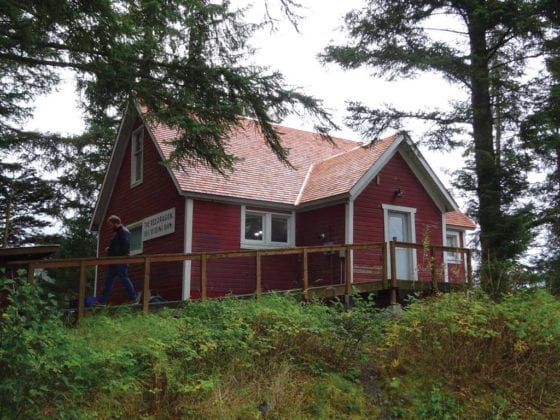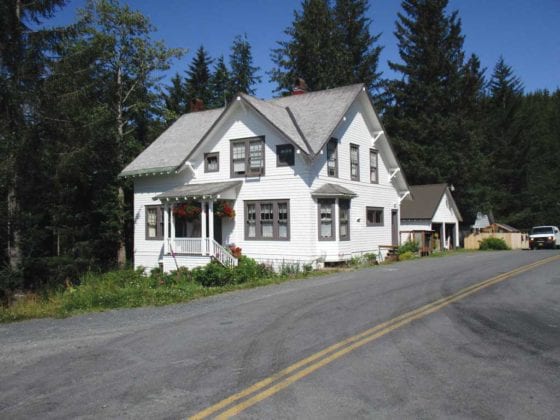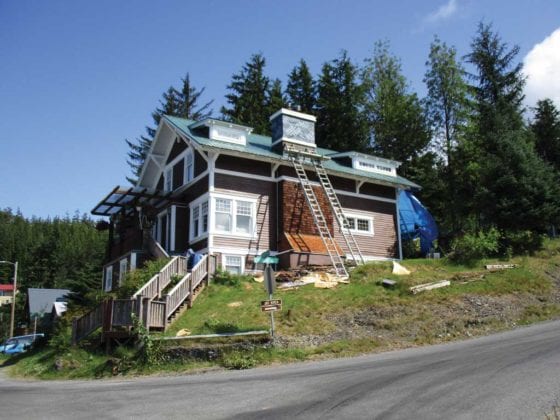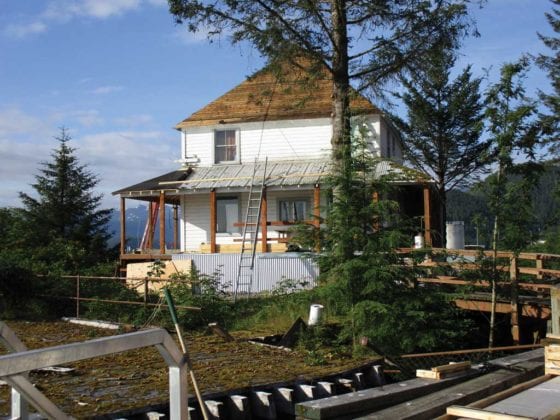Several local buildings with rich histories that date back to Cordova’s earliest days are receiving repairs, remodeling or paint jobs.
None has a more entertaining background than the Jack Dalton house, a four-eaved structure located across the docks from Copper River Seafoods. Currently owned by Sylvia Lange and Greg Meyer, the Dalton House was built on Three Tree Point sometime prior to 1909.
Dalton, a famous Alaska character, filed three mineral claims adjacent to land surveyed for Michael Heney in 1906 that would include access to proposed dock facilities for the Copper River and Northwestern Railway. When workers began to lay rail to the dock area they ran into troubles with Dalton, who claimed they were interfering with his access to the ocean. He filed a claim to stop them on Oct 7, 1908. A second court decision by the Juneau Land Office and Courts in 1911 found in favor of the railroad, as had an earlier local decision in 1909.
How much Heney paid Dalton for the home and property is not known, but Meyer mentioned a pair of small mine shafts in rock just behind the house.
“I think it’s pretty obvious he was just speculating, but it paid off.”
Either wharf masters or steamship agents used the home for many years, before being occupied by cannery personnel. When Meyer and Lange took over the dock and facilities, they did extensive remodeling of a nearby warehouse, converting it into an expansive home. Meanwhile the Dalton House was falling into disrepair.
“We’ve decided to remodel it into our home, and convert our existing place into a B&B,” Meyer said. “It has a great view, and has such historical significance. Plus we’ll be able to tie our sailboat up right below it, thanks to Dalton.”
The Red Dragon, probably a more familiar local historic building, is also receiving much need repairs in the form of a new cedar shingle roof. Carbon Neutral Alternatives is doing the work, and it is funded by numerous grants and donations. Because of its historical designation, materials used in restoration must match the original design.
Contrary to some modern viewpoints, this famous landmark was not the first structure to be built on the Cordova Townsite. Prior to 1908, Cordova was located in “Old Town,” an area that includes the present day hospital and land beyond, toward Eyak Lake. A small tramway carried fish from the lake to a large cannery at the head of Odiak Slough. The railway bought out those facilities to serve as headquarters for construction, and many businesses sprung up nearby.
Meanwhile, in 1905 a group of five Valdez businessmen, headed by T.J. Donahue, had speculated that the modern Cordova location would be ideal for shipping coal from Katella, and had it surveyed and platted by 1908.
Situated closer to the harbor and railway terminus, the move to the new Cordova Townsite was about to begin. Over $100,000 raised by sale of lots was used to build streets and make improvements on the rocky, hilly terrain which provided ideal drainage during periods of heavy rain.
The first structure to be completed in the new townsite was, not surprisingly, the Northern Saloon, which opened its doors on July 14, 1908. The Red Dragon, built as a clubhouse and Episcopal Mission, was completed four days later. The story goes the Northern Saloon owner outbid missionary Rev. Newton for a pile of scarce lumber to gain an advantage.
Building a railway generated a lot of thirst, for sure. Old photos reveal every fourth building on Main Street was a water hole. One could say spiritual needs of one sort won out over spiritual needs of another. However, it is noteworthy that 108 years later the Red Dragon still stands, while the Northern Saloon is long gone.
Two other famous Cordova buildings right across the street from each other have received or are receiving paint jobs. Diane Ujioka’s house up on Council Street was built in 1910 by George Hazelet, one of the Valdez Five. He became Cordova’s first mayor, helped map the town site, and for the remainder of his life was one of the town site’s trustees. Charlie and Freida Craft, Karl and Florence Barth, Laura Brown and Ralph Treffers followed as owners before Ujioka.
The Donohue house was built in 1919 by attorney T.J. Donahue, also of the Valdez Five. It has the unusual Cordova distinction of being owned by only two families. It was sold in October 1945 to Merle K. and Bertha Smith, and is now owned by his son Wayne Smith and wife Diann. Merle was a famous pioneer aviator who came to Cordova in the 1930’s and established Cordova Air Service, which eventually merged with Alaska Airlines. The Mile 13 Airport is named Merle “Mudhole” Smith, and the source of his nickname is a whole different story.
The truth is, Cordova is fortunate to have so many remaining historical buildings, and people who are committed to keeping them in good condition. If you are interested in reading more about these and many others, check out Nikki Nielsen’s “From Fish and Copper: Cordova’s Heritage and Buildings,” Alaska Historical Commission Studies in History No. 124, available at the Cordova Museum.


















